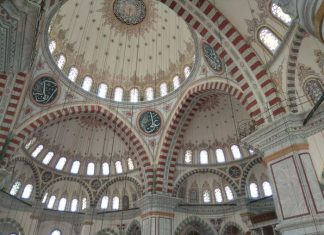So in the First Commandment we must distinguish the clauses — “Thou shalt not have strange gods before me”, “Thou shall not adore them nor serve them” — which are eternal natural law (prohibitum quia malum), from the clause: “Thou shalt not make to thyself any graven image”, etc. In whatever sense the archaeologist may understand this, it is clearly not natural law, nor can anyone prove the inherent wickedness of making a graven thing; therefore it is Divine positive law (malum quia prohibitum) of the Old Dispensation that no more applies to Christians than the law of marrying one’s brother’s widow.
Since there is no Divine positive law in the New Testament on the subject, Christians are bound firstly by the natural law that forbids us to give to any creature the honour due to God alone, and forbids the obvious absurdity of addressing prayers or any sort of absolute worship to a manufactured image; secondly, by whatever ecclesiastical laws may have been made on this subject by the authority of the Church The situation was defined quite clearly by the Second Council of Nicaea in 787.
Fathers drew up the essential decision
In its seventh session the Fathers drew up the essential decision (horos) of the synod. In this, after repeating the Nicene Creed and the condemnation of former heretics, they come to the burning question of the treatment of holy images. They speak of real adoration, supreme worship paid to a being for its own sake only, acknowledgment of absolute dependence on some one who can grant favours without reference to any one else.
This is what they mean by latreia and they declare emphatically that this kind of worship must be given to God only. It is sheer idolatry to pay latreia to any creature at all. In Latin, adoratio is generally (though not always; see e.g. in the Vulgate, 2 Samuel 1:2, etc.) used in this sense. Since the council especially there is a tendency to restrict it to this sense only, so that adorare sanctos certainly now sounds scandalous. So in English by adoration we now always understand the latreia of the Fathers of the Second Nicaean Council.
From this adoration the council distinguishes respect and honourable reverence (aspasmos kaitimetike proskynesis) such as may be paid to any venerable or great person-the emperor, patriarch, and so on. A fortiori may and should such reverence be paid to the saints who reign with God. The words proskynesis (as distinct from latreia) and douleia became the technical ones for this inferior honour. Proskynesis (which oddly enough means etymologically the same thing as adoratio — ad + os, kynein, to kiss) corresponds in Christian use to the Latin veneratio; douleia would generally be translated cultus. In English we use veneration, reverence, cult, worship for these ideas.
Read More about A Brown Woman part 5
Read More about A Brown Woman part 5








